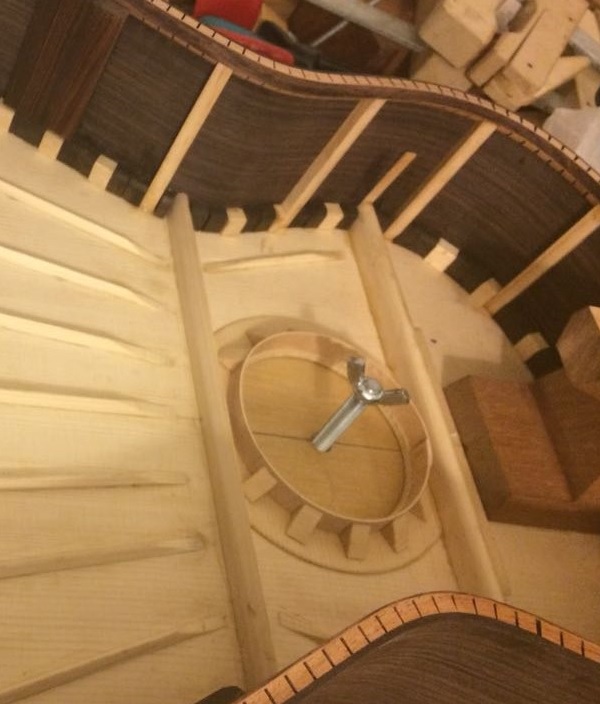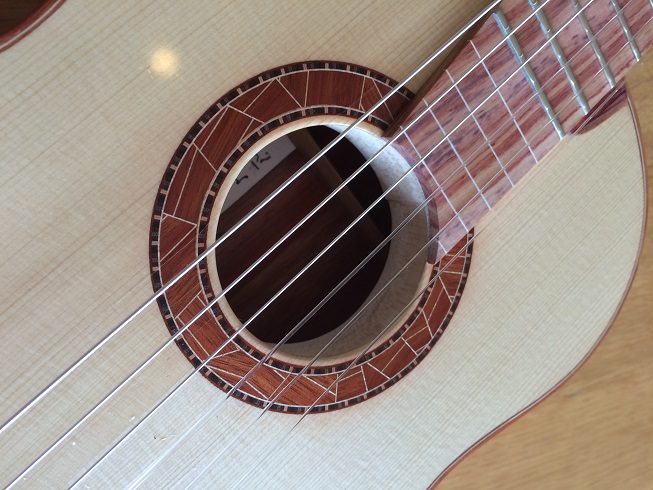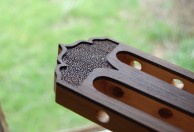Welcome to one of the most active flamenco sites on the Internet. Guests can read most posts but if you want to participate click here to register.
This site is dedicated to the memory of Paco de Lucía, Ron Mitchell, Guy Williams, Linda Elvira, Philip John Lee, Craig Eros, Ben Woods, David Serva and Tom Blackshear who went ahead of us.
We receive 12,200 visitors a month from 200 countries and 1.7 million page impressions a year. To advertise on this site please contact us.
|

|
|
deep tuned guitars
|
You are logged in as Guest
|
|
Users viewing this topic: none
|
|
Login  | |
|

   
benros
Posts: 144
Joined: Aug. 27 2016

|
 deep tuned guitars deep tuned guitars
|
|
|
hey guys,
the guitars that impressed me most so far, have all really deep tuned body resonances (something between d, e flat and e) and i like to know, who feels the same, what you think about it. i have found a video on youtube about some hausers and a santos and the guy who talks, says some really reasonable thinks about the qualities of deep tuned guitars (https://m.youtube.com/watch?v=1RFXDfsdc-A).
a question, that came to my mind is: is it just the lightness of the built that influences the zero tone or are the other factors, that one have to put into consideration, if he wants to come out soooo deeeeep?
any thoughts, suggestions?
greetings,
ben
|
|
|
|
REPORT THIS POST AS INAPPROPRIATE |
Date Feb. 2 2017 20:31:06
 |
|

   
benros
Posts: 144
Joined: Aug. 27 2016

|
 RE: deep tuned guitars (in reply to Echi) RE: deep tuned guitars (in reply to Echi)
|
|
|
hey guys, im trying to build a deep tuned guitar and just asking, if someone has a hint, how to accomplish that, i.e. what constructional elements influence the zero frequence most. i know, that lightness is an important factor to do so. the size of the box and the soundhole seem to be also a part of the equation. has someone of you build a guitar pitched between e and d and any idea how he have done that?
john, i think what the guy in the video says is definitely generalizable or is at least meant as a try to characterize the quality of deep voiced guitars in general (probably the santos in the video would make a good blanca). ive heard two blancas which were around e and they both had something in common, im striving for. and i heard torres la leona in natura a few month ago and it had the same kind of character (and is pitched in d, i think and is a very thiny guitar with a tornavoz).
stephen, im interested in building a deep tuned guitar and just asking if someone, who have built one/some, have an idea, how to accomplish that, since i think communication with professionals or experienced amateurs is a good way to learn something. i have heard a lot of weirdo customer anecdotes from luthiers and you and anyone who needs to deal with that kind of clientel have my heartfelt sympathy.
echi, the two low pitched guitars that i have examined so far, have both very thin soundboards (something around 1,5-1,8mm) and braces, but are different in terms of boxsize and thickness/weight of the backs and sides. only one of them, a cypress esteso replica, is very light (1100gr with machines), very thin back and sides (under 2mm) and has a very small plantilla (350mm im the lower bout). but the other one weighs around 1400 gr., has a much bigger plantilla. so the mass of the soundboard seems to be the most important factor and the overall weight-boxsize-ratio seems to be also important, probably lower stiffness of the box also...
|
|
|
|
REPORT THIS POST AS INAPPROPRIATE |
Date Feb. 3 2017 8:46:51
 |
|

   
mqbernardo
Posts: 47
Joined: Mar. 26 2012

|
 RE: deep tuned guitars (in reply to benros) RE: deep tuned guitars (in reply to benros)
|
|
|
http://newt.phys.unsw.edu.au/jw/Helmholtz.html
Hi, this link shows how that “zero frequency “ approximately works, the main difference being that a guitar has pretty flexible walls. Sorry if you already knew all this.
From the equation, some ways of lowering the lowest air resonant frequency become apparent: Increasing the size of the box, decreasing soundhole area and increasing soundhole length. Other ways are increasing the flexibility of the “walls” or moving the soundhole closer to the boundaries of the instrument.
These all work, but in a guitar making context some are easier than others to achieve. You can only alter the dimension and position of the soundhole to a small extent, if you want to stay within tradition (which, of course, you can forget all about). There are structural limits to increasing the flexibility of the box (note that I don´t think that in the particular context of air resonances the top has any prevalence over the other “walls” – it just happens to be a big and flexible wall, but if you make the back less stiff it will lower the air frequency accordingly too).
An obvious thing to do would be increasing the height of the sides, but from a select diet of hands-off forum trivia over the years, I have learnt (not from experience) that it turns out you would have to make really tall sides to have an audible difference - google something like “Fred Dickens guitar side height”, and you´ll get the gist of it.
Another option would be to increase the soundhole height by using a tornavoz. Fancy ones are made from brass, but i´ve made mine from a quartered 1 mm maple veneer: cut it to the desired height ( I used it at 12 and 16 mm IIRC), bend on the hot pipe and then let it cool wrapped and roped to a glass jar that fits the size of the soundhole (FWIW I use a wurtz jar, a tornavoz is the best excuse to eat sausages i´ve yet found – kids love the tornavoz!). I then glue it around the soundhole with the aid of peones / dentellones.
The thing is I think the tornavoz makes the guitar have a slower response, for lack of better words, which I don´t think the flamenco crowd finds desirable. It seems to be more of a classical thing, I concur – but it does seem to give you tremendous bass. As disclosure, i´ve only built two guitars with a tornavoz.
Another thing is I don´t think you can actually predict accurately what the resulting air resonance (or any other, for that matter) will be – it depends on too many variables (down to minute things like binding dimensions).
Again, sorry if you knew all this. Writing it helps to make it clear for me as well.
Good luck,
Miguel.
- edited for typos -
|
|
|
|
REPORT THIS POST AS INAPPROPRIATE |
Date Feb. 3 2017 13:50:26
 |
|

   
Richard Jernigan
Posts: 3430
Joined: Jan. 20 2004
From: Austin, Texas USA

|
 RE: deep tuned guitars (in reply to jshelton5040) RE: deep tuned guitars (in reply to jshelton5040)
|
|
|
One way of finding the main air resonance is to sing into the soundhole, and listen for the note to be reinforced.
I did this to three of my guitars last night. For the Arcangel blanca the resonance is a little above F# on the sixth string. You can feel the whole guitar vibrate with the fingers holding it. When Richard Bruné appraised it before I bought it, he remarked on the thin top. When Ricardo posted the video on him playing it, people said it sounded ¨deep¨ or had a strong bass.
The spruce-Brazilian Abel Garcia classical's air resonance is just about at G on the sixth string. This guitar has a strong mid-range. If I have been playing it for a while and switch to a different classical, I notice that I need to put a little more energy into the second and third strings of the second guitar.
The Tom Blackshear cedar/Indian Rodriguez model resonates a little above F# on the 6th string, but the peak of the resonance is broader than that of the Arcangel. The Blackshear reinforces a broader range of pitch around the strongest point. This guitar has a strong and deep bass, but it is balanced all the way up to the highest treble. The Blackshear does have some notes that are a little weaker than the others, at least as the player perceives it. For example c on the 1st string is a little weaker than the b next to it. But this guitar has a strong sympathetic response. That is, playing on one string you can clearly hear other strings responding sympathetically. There are more sympathetic responses to the b than to the c. I also feel the sound of this guitar against my chest and arms more than I do any of the others I own.
I have no idea what this would all sound like to a listener out in front of the instrument. But I really like what I hear and feel.
I speculate that if the Arcangel were mic'ed and played over a P.A., you might need to cut the bass a little, but I really like the sound when I play it in my practice room.
Maybe I'll record some of the instruments and analyze the data to see whether I can detect separate air and top resonances?
While reductionist scientific analyses may shed a little light on guitar making, the instrument is sufficiently complex that I believe luthiery will remain an art for the foreseeable future.
RNJ
|
|
|
|
REPORT THIS POST AS INAPPROPRIATE |
Date Feb. 6 2017 15:54:42
 |
|

   
estebanana
Posts: 9351
Joined: Oct. 16 2009

|
 RE: deep tuned guitars (in reply to benros) RE: deep tuned guitars (in reply to benros)
|
|
|
Most flamenco guitars that are in the pocket have a main air resonance in the F# to G to G#, getting up to A is asking for trouble and a difficult to handle guitar that can be too forward with overtones and finicky.
Ok that said for the maker the action is in the main top and back modes, that is not the same as the main air resonance. The separation of pitch difference between top and back modes is important. The basic reason is that you don't want them to vibrate in phase with each other on one pitch, the pitches need separation, and depending on how you want to work that can mean anything from a good half step to many steps.
To find the main top and back modes, when you are changing strings, put your hand into the sound hole reach around and pinch lower transverse brace with your thumb ad fore finger and block the soundhole closed with your back palm with out touching the sides of the soundhole. Tap the top and back and listen carefully.
Tap on top of the bridge and you generally get the main top mode, tap around it and you get other modes, which we won't go into. Tap the back in the middle of the lower bout, you generally get the main back mode, tap up the back until the pitch changes.
Generally good exchange between top and back on a successful well balanced flamenco guitar, a blanca, is not a lot of pitch distance between top and back, but enough to separate them so they don't beat in phase on key notes like say open A, that is death for a guitar. I'm not going to say what I shoot for, but I will say it seems the best well rounded flamenco guitars with good voice also have a steady main air mode up the back as you tap higher. In other words the back is not super 'tight' and the main mode pitch of the back does not change wildly and quickly as you tap in different places. The back is kind of mello pitched reflector not a super active participant. The main air resonance to me is not that important as the way the relationship between the back and top modes are handled. And in many respects this shapes or pitches the main air res.----ok don't go to sleep on that concept.
If you want to break it out in a simple thing you can remember this is how my teacher Gene Clark gave it to me as a working mantra- "The top is a snare drum, the back is a tabla." - That means separate the pitches between back and top. All the other stuff has effect too, like all the stuff you talk about with regard to brace patterns etc. but that system sets up the relationship between the back and top. The basic plan is to keep the back from messing with what the top is trying to do.
The deal with main air resonance is that the iceberg is mostly under the sea, and most people are obsessing over the main air res without seeing the jagged menace in the depths. It's not as simple as judging why a guitar does this or that based on what note the box sits on. It's a far more difficult equation. One can also be well informed on this kind of theory and get it into your building practice and you still must rely a great deal on your intuition informed by your past success and failure. All things about resonance in the top are set up by other decisions you make like top thickness and bridge design and tuning up, main air is a product of 20 or 30 other decisions and those decisions are the knowledge not simply a top resonance.
You can take five guitars all with a main top res of F# and they will all be different. Get it? One person may not like to play all five, they might favor only one.
_____________________________
https://www.stephenfaulkguitars.com
|
|
|
|
REPORT THIS POST AS INAPPROPRIATE |
Date Feb. 8 2017 0:30:11
 |
|
 New Messages New Messages |
 No New Messages No New Messages |
 Hot Topic w/ New Messages Hot Topic w/ New Messages |
 Hot Topic w/o New Messages Hot Topic w/o New Messages |
 Locked w/ New Messages Locked w/ New Messages |
 Locked w/o New Messages Locked w/o New Messages |
|
 Post New Thread
Post New Thread
 Reply to Message
Reply to Message
 Post New Poll
Post New Poll
 Submit Vote
Submit Vote
 Delete My Own Post
Delete My Own Post
 Delete My Own Thread
Delete My Own Thread
 Rate Posts
Rate Posts
|
|
|
Forum Software powered by ASP Playground Advanced Edition 2.0.5
Copyright © 2000 - 2003 ASPPlayground.NET |
0.09375 secs.
|


 Printable Version
Printable Version














 New Messages
New Messages No New Messages
No New Messages Hot Topic w/ New Messages
Hot Topic w/ New Messages Hot Topic w/o New Messages
Hot Topic w/o New Messages Locked w/ New Messages
Locked w/ New Messages Locked w/o New Messages
Locked w/o New Messages Post New Thread
Post New Thread